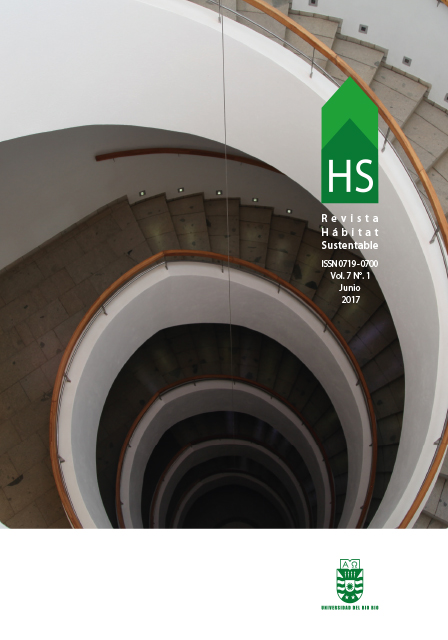Validation of Alonso-Frank & Kuchen's methodological tool to determine the energy efficiency level indicator for users of a high-rise residential building in San Juan, Argentina.
Keywords:
energy efficiency label for users, thermal comfort, user efficiency level, energy efficiency label for usersALCIÓN DE LAS PLÉYADES ALONSO FRANKInstituto Regional de Planeamiento y Hábitat - Facultad de Arquitectura, Urbanismo y Diseño (FAUD) - Universidad Nacional de San Juan (UNSJ), San Juan, Argentinaalcion88@hotmail.comERNESTO KUCHEN Instituto Regional de Planeamiento y Hábitat - Facultad de Arquitectura, Urbanismo y Diseño (FAUD) - Universidad Nacional de San Juan (UNSJ), San Juan, Argentinaernestokuchen@faud.unsj.edu.arAbstract
The residential sector represents the largest consumer of energy in the building sector. Although in recent years there has been an increase in regulations and projects to establish strategies for the rational and efficient use of energy, this process is still underway. This research is based on the hypothesis that users are responsible for the unforeseen energy consumption during building use. The objective is to validate a methodological tool that expresses the User Efficiency Level (Nivel de Eficiencia del Usuario, NEU) of a high-rise residential building located in San Juan, Argentina. To this end, a survey was carried out in the building. The habits that the average users use to satisfy their thermal comfort in summer were revealed. The values were then shown in the graphic form of a label. The evaluation of results demonstrated the massive use of passive strategies that do not consume energy, instead of active strategies, thereby leading to a low energy consumption of 14.6 kWh/m2 Person. Correspondingly, the User Efficiency Level indicator found was valued as "good" and did not correlate with parameters such as user age, number of inhabitants per home or dwelling floor. Therefore, it is concluded that energy efficiency level depends on user awareness of energy consumption.
Downloads
References
AUTOR 1 (2015)
AUTOR 2 (2016)
BRIANO, J.; BÁEZ, M. & MOYA MORALES, R. Eficiencia energética en Argentina: Identificación de oportunidades. Dirección de Análisis y Estrategia de Energía (DAEE). Editor: CAF. 2016
DECRETO LEY N° 140. PRONUREE: Programa Nacional de uso racional y eficiente de la energía. Interés y prioridad nacional. Poder Ejecutivo Nacional (P.E.N.). Publicada en el Boletín Oficial del 24-dic-2007. Número: 31309. 2007. p. 4.
Decreto P.E.N. N° 231/2015. Creación de la Secretaría de Planeamiento Energético Estratégico y de la Subsecretaría de Ahorro y Eficiencia Energética (entre otras).
EPRE - ENTE PROVINCIAL REGULADOR ELÉCTRICO. Consumo energético anual [en línea], 2015. [Consultado 20 febrero 2016]. Disponible en: http://www.epresj.gov.ar.
JUODIS, E.; JARAMINIENE, E. y DUDKIEWICZ, E. Inherent variability of heat consumption in residential buildings. Energy and Buildings, 2009, vol. 41, pp. 1188-1194.
KURBÁN, Alejandra. DIMENSIÓN: URBANO-AMBIENTAL. Ambiente Socialmente Construido. Plan de Ordenamiento Territorial para el Área Metropolitana de San Juan PLAM-SJ. Programa de fortalecimiento institucional de la subsecretaría de planificación territorial de la inversión pública. Segundo informe – Mayo 2012.
NORMA IRAM 11603 - Instituto Argentino de Normalización y Certificación: Acondicionamiento térmico de edificios. Clasificación bioambiental de la República Argentina. Buenos Aires. Argentina, 1996.
RUÁ, M. J.; LÓPEZ-MESA, B. Certificación energética de edificios en España y sus implicaciones económicas. Informes de la Construcción, 2012, vol. 64, no 527, p. 307-318.
SECRETARÍA DE ENERGÍA DE LA NACIÓN (SEN) [en línea]. [Consultado 17 enero 2017]. Disponible en http://www.energia.gov.ar
Downloads
Published
How to Cite
Issue
Section
License
The content of articles which are published in each edition of Habitat Sustentable, is the exclusive responsibility of the author(s) and does not necessarily represent the thinking or compromise the opinion of University of the Bio-Bio.
The author(s) conserve their copyright and guarantee to the journal, the right of first publication of their work. This will simultaneously be subject to the Creative Commons Recognition License CC BY-SA, which allows others to share-copy, transform or create new materials from this work for non-commercial purposes, as long as they recognize authorship and the first publication in this journal, and its new creations are under a license with the same terms.











 Scientific Information Program/Concurso Fondos de Publicación de Revistas Científicas 2018/ Proyecto Mejoramiento de Visibilidad de Revistas UBB (Código:FP180007).
Scientific Information Program/Concurso Fondos de Publicación de Revistas Científicas 2018/ Proyecto Mejoramiento de Visibilidad de Revistas UBB (Código:FP180007).





